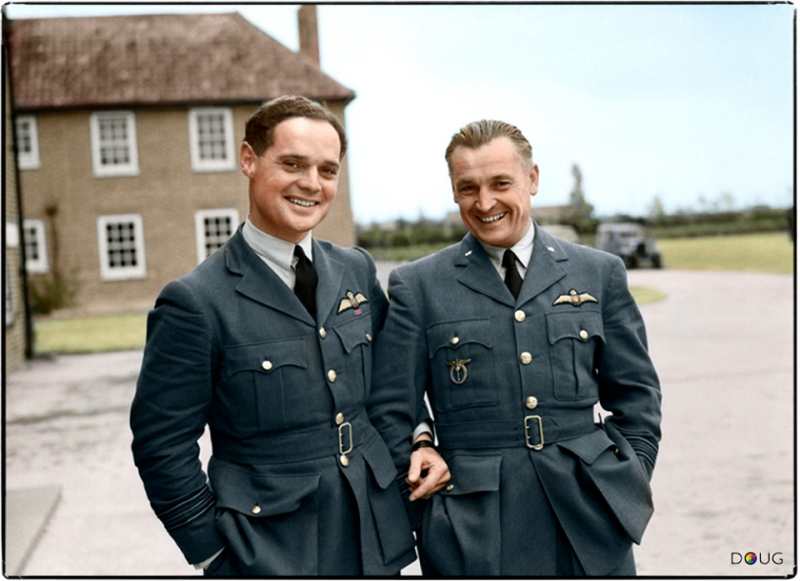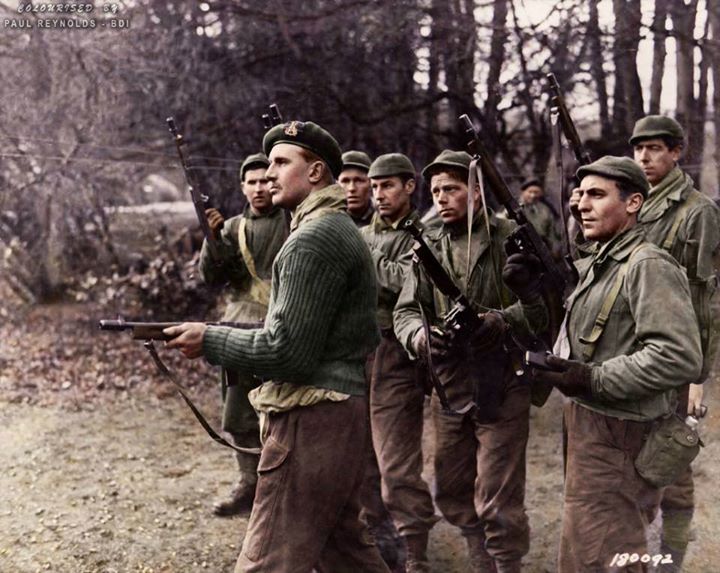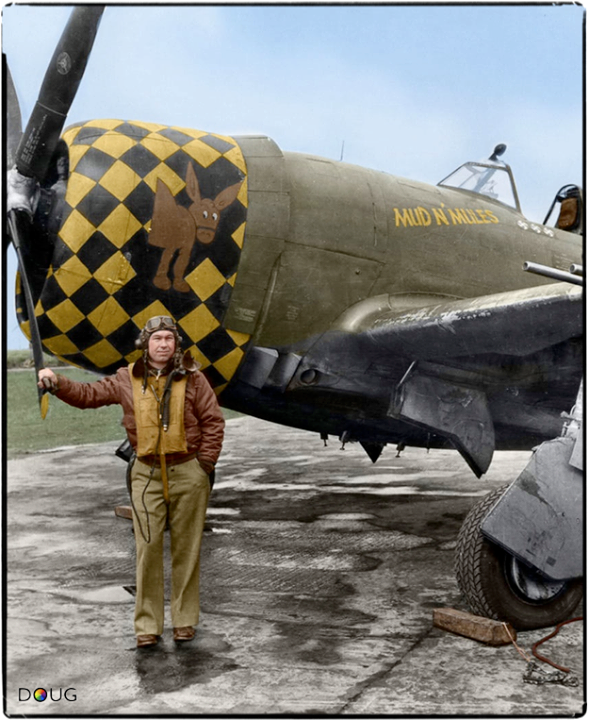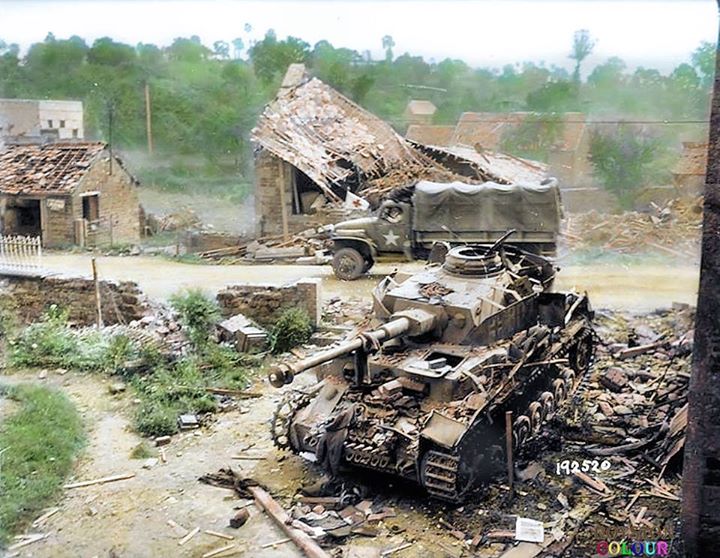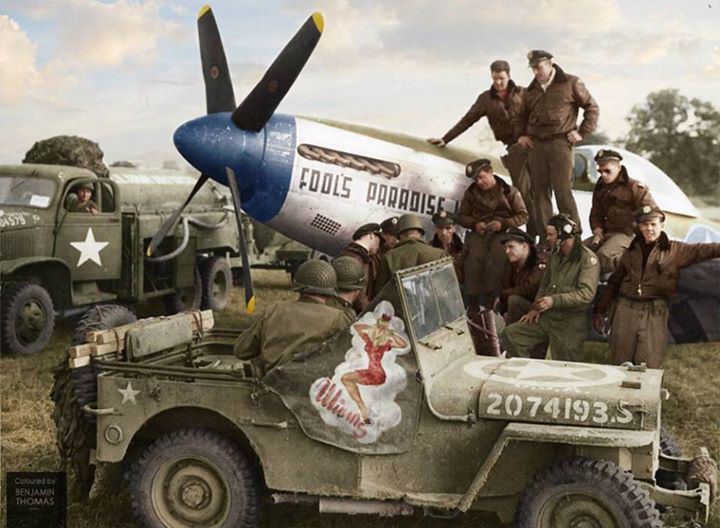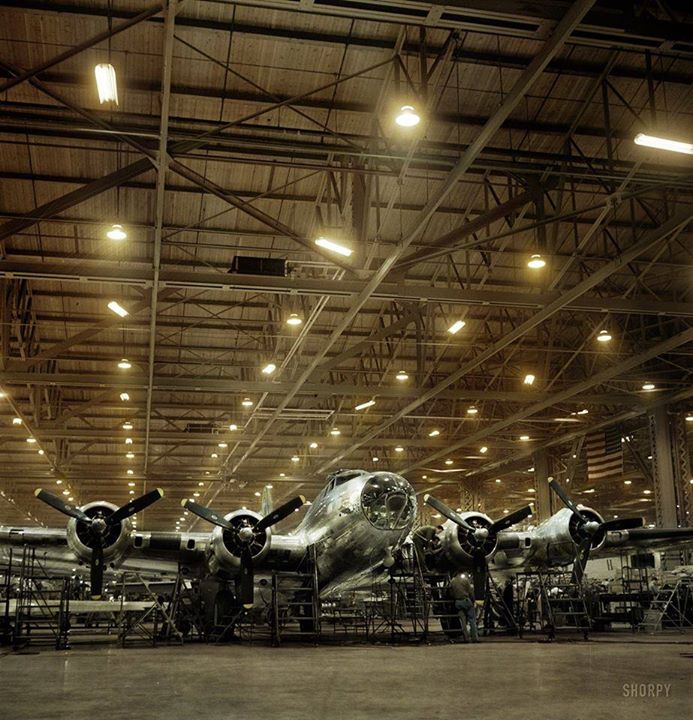We are used to viewing the war in black and white. So when you get to see colourised images it brings the war to us with a different dimension. The images are produced by using the colourised technique and are by the ‘Colourise History Group’ and you can follow the guys via their Facebook group WW2 Colourised Photos
“Ekins versus Wittmann”
SS-Hauptsturmführer Michael Wittmann of sSSPzAbt 101/1st SS Division Leibstandarte SS Adolf Hitler in a Panzer VI ‘Tiger 1’ Nº 007
and – Trooper Joe Ekins of 3 Troop, A Squadron, 1st Northamptonshire Yeomanry in a Sherman Vc Firefly Nº12 (‘Velikye Luki’)
8th of August 1944, in a field next to the road of Caen- Cintheaux, near Gaumesnil, Normandy.
The most accepted opinion is that Wittmann and his crew were killed from a shot from a Sherman Vc Firefly, from 3 Troop, A Squadron, Northamptonshire Yeomanry. This Firefly, the ‘Velikye Luki’, under the command of Sergeant Douglas Gordon was operating with three other Fireflies commanded by Captain Thomas Boardman when they encountered three Tigers. They fired on these Tigers which were all three destroyed in a couple of minutes. The first Tiger was destroyed at 12.40 hours and the second, which returned fire, exploded at 12.47 hours. The third Tiger, probably the ‘007’, was put out of action with two shells, fired by gunner Trooper Joe Ekins from the Firefly of Sergeant Gordon. This was written down in the official daily journal of A Squadron.
Michael Wittmann 22nd April 1914 – 8th August 1944 (died aged 30)
Joe Ekins 15th July 1923 – 1st February 2012 (died aged 88)
(Nb. The total score of victories for Wittmann till 8 August, 1944 was 141 tanks and 132 anti-tank guns. Most of these victories were made on the Eastern Front.)
(Colourised by Doug)
http://
General Feld Marschall Erwin Rommel inspecting the 21.Panzer Division in Normandy on the 30th of May 1944
Rommel believed that the invasion needed to be stopped on the beaches, Gerd von Rundstedt the Commander-in-chief West, along with Geyr von Schweppenburg (Panzer Group West) disagreed. Hitler vacillated and placed the armour in the middle, far enough back to be useless to Rommel, not far enough for von Rundstedt. As a result of this, the 21st Panzer was placed near Caen, in the area of the British /Canadian landings.
If they had been released during the night of the 5th-6th they could have been on the beachhead waiting for the Allies to land. The SS units that were supposed to support the division could not be released as they were under Hitler’s direct command.
For the first day of the Allied landings, 21st Panzer operated alone. Hampered by enemy air attacks, it managed to find and engage British Paratroop forces at Ranville. The division gave the British a hard fight until it received orders to withdraw in the late morning.
Ordered to check the British advance on Caen in the evening, the Germans succeeded in reaching the coast at Lion-sur-Mer and drove a wedge between the British 3rd Infantry and the 3rd Canadian Divisions.
The last major action the 21st Panzer took part in on the Western Front was the stubborn resistance it gave the Guards Armoured Division during Operation Bluecoat, on the 1st of August 1944.
The surviving forces of the 21st Panzer were then almost entirely lost in the Falaise Pocket. The remnants of the unit merged with the 16th Luftwaffe Field Division. Of the 223 tanks of the 21st and other Divisions captured in the area by British forces between 8–31 August, about three quarters were abandoned/destroyed by their crews.
(The vehicle on the left (WH-431715) is believed to be one of the rare Selbstfahrlafette fur 7.5cm PaK40 auf Somua MCG S307(f) — a German self-propelled PaK 40 based on captured French Somua halftracks. A few of these were used by the 21st Panzer Division around Caen in Normandy in 1944.)
(Colourised by Olly Hagar from the UK)
https://www.facebook.com/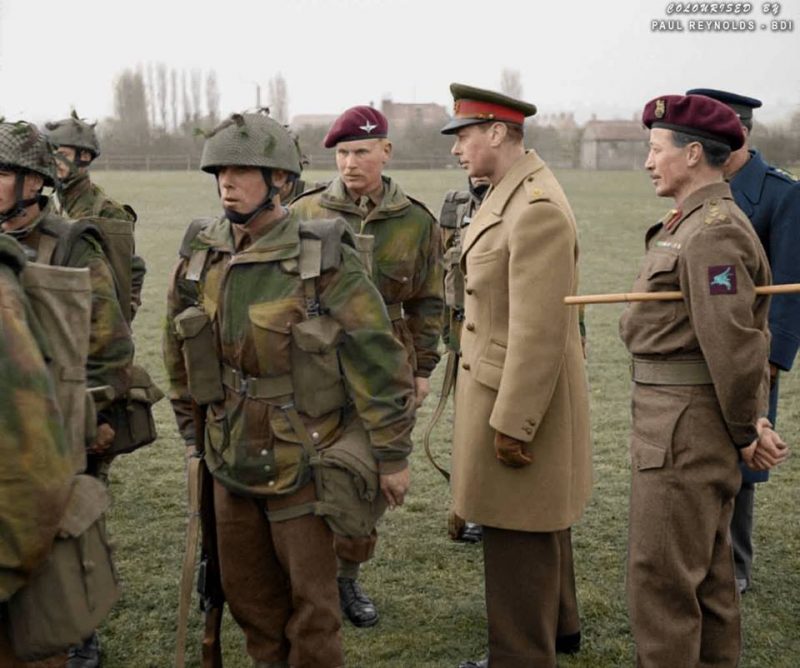
King George VI inspects British 1st Airborne troops in training, 16th of March 1944.
To the King’s left wearing the Pegasus patch is Brigadier John ‘Shan’ Hackett, 4th Parachute Brigade and to the King’s right is Lt. Col. Kenneth Smyth, 10th Parachute Battalion.
Having returned to England from Italy in December 1943, the division then prepared for the invasion of France. It was not involved in the Normandy landings, being held in reserve. In September 1944 it took part in Operation Market Garden. The division landed 60 miles (97 km) behind German lines, to capture crossings on the River Rhine, and fought in the Battle of Arnhem. After failing to achieve its objectives, the division was surrounded and took heavy casualties, but held out for nine days before the survivors were evacuated.
Lt.Col K Smyth died of his wounds received at Arnhem on the 26th October 1944
Brigadier ‘Shan’ Hackett survived the war, and died in September 1997.
Colourised and Researched by Paul Reynolds.
https://www.facebook.com/
Historic Military Photo Colourisations) 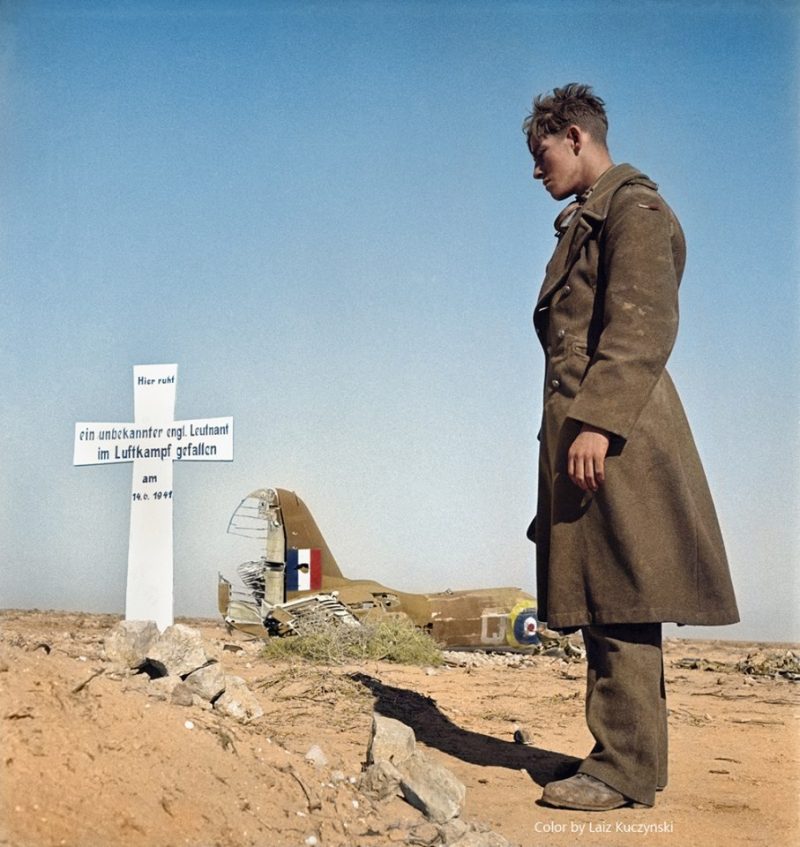
This is a famous photo taken by the British War Correspondent, George Rodger. It is of a British soldier standing by the grave of an English Flight Lieutenant and the inscription reads;
“Here lies an unknown English Lieutenant who died in Air Battle”.
14.6.1941
According to the Imperial War Museum, the partially burnt out aircraft is a Martin Maryland Mk.II of Nº 39 Squadron RAF in the image taken by Lt. Cash of the No 1 Army Film & Photographic Section, Army Film & Photographic Unit (E7297).
That image shows the graves of three British airmen, in an area situated south west of Gazala, Libya.
We were unable to establish the identity of these airmen or that of the Maryland with the letter ‘Q’ on the fuselage.
(We believe that the soldier in the photo could be George Rodger’s driver)
(Nb. On the 14th of June 1941, a Martin Maryland of Nº 24 Squadron SAAF, was shot down near Ain el Gazala but the Pilot (J.C. Newborn) parachuted to safety and was taken prisoner by the Germans (no record of the other two crew).
(Colourised by Laiz Kuczynski)
https://www.facebook.com/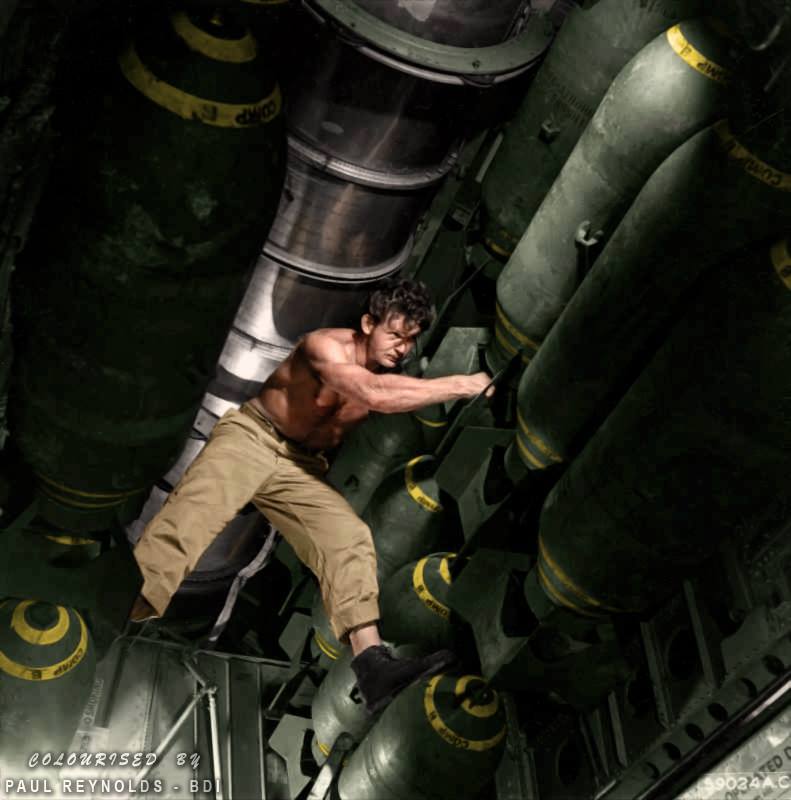
(Nb the B-29 could carry 32 x 500lb GP Bombs)
(Colourised by Paul Reynolds.
https://www.facebook.com/
Historic Military Photo Colourisations)
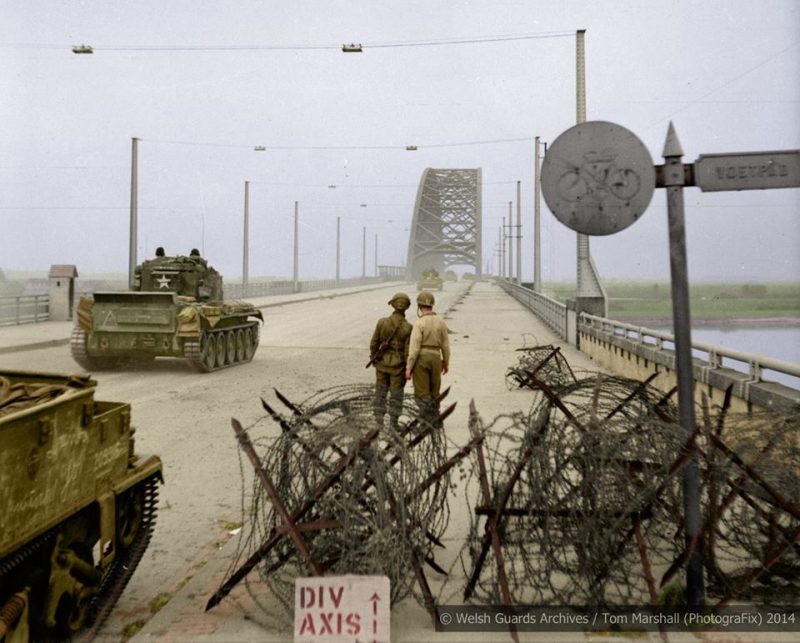
This bridge was located approximately ten miles from Arnhem and was described by General Eisenhower as a ‘valuable prize’.
It marked the entry point to the flat piece of land that divided the River Waal from the Lower Rhine, which was called ‘the Island’. The exposed single road north often proved to be a bottleneck as vehicles were vulnerable to enemy fire.
This image is one of a series colourised by Tom Marshall for a new book by Trevor Royle on the history of the Welsh Guards 1915-2015. ‘Bearskins, Bayonets & Body Armour’ is available to purchase now from Pen and Sword Books at half price here; http://
Original image © Welsh Guards Archives. Colourised Image © Welsh Guards Archives / Tom Marshall 2014. All rights reserved.
(Colourised by Tom Marshall from the UK)
http://www.facebook.com/
Two Duxford-based Battle of Britain pilots.
Squadron Leader Douglas Bader, commanding No. 242 (Canadian) Squadron, with Major Alexander ‘Sasha’ Hess, CO of No. 310 (Czechoslovak) Squadron, outside the Officers Mess building, Duxford, Cambridgeshire. October 1940.
RAF Duxford was a Sector Station in 12 Group, responsible for defending the Midlands and East Anglia in England.
(Source – IWM CH1340)
(Nb, Douglas Bader is wearing the Distinguished Service Order, medal ribbon that he was awarded on the 1st of October 1940.)
‘Sacha’ Hess was a Czechoslovakian pilot who, like many others carried on fighting after his country was invaded by Germany.
He was born in 1898, and was therefore one of the oldest pilots who flew in the Battle.
The Czechs were fine men and most had suffered terrific hardships in their escape from Czechoslovakia after the German invasion. As one instance, Sasha Hess’ wife and daughter had been taken to a concentration camp and he had been informed they were dead. He could only hope that they died quickly, but he vowed that he would never show any mercy to any German and would never take any prisoners.
On the first occasion the Czechs got into action…Hess had disabled a Dornier …he followed it down with the intention of making certain that no one got out of it alive. He saw three Germans climb out, who held up their hands when they saw Sasha diving on them. To quote his own words: “I hesitate, then it was too late, so I go round again to make sure I kill them – they wave something white, again I did not shoot…’ (disgustedly) ‘I think it is no use, I am becoming too b****y British!”
Douglas Bader died on the 5th of September 1982 aged 72
Alexander Hess died on the 10th of August 1981 aged 83
(Colourised by Doug)
http://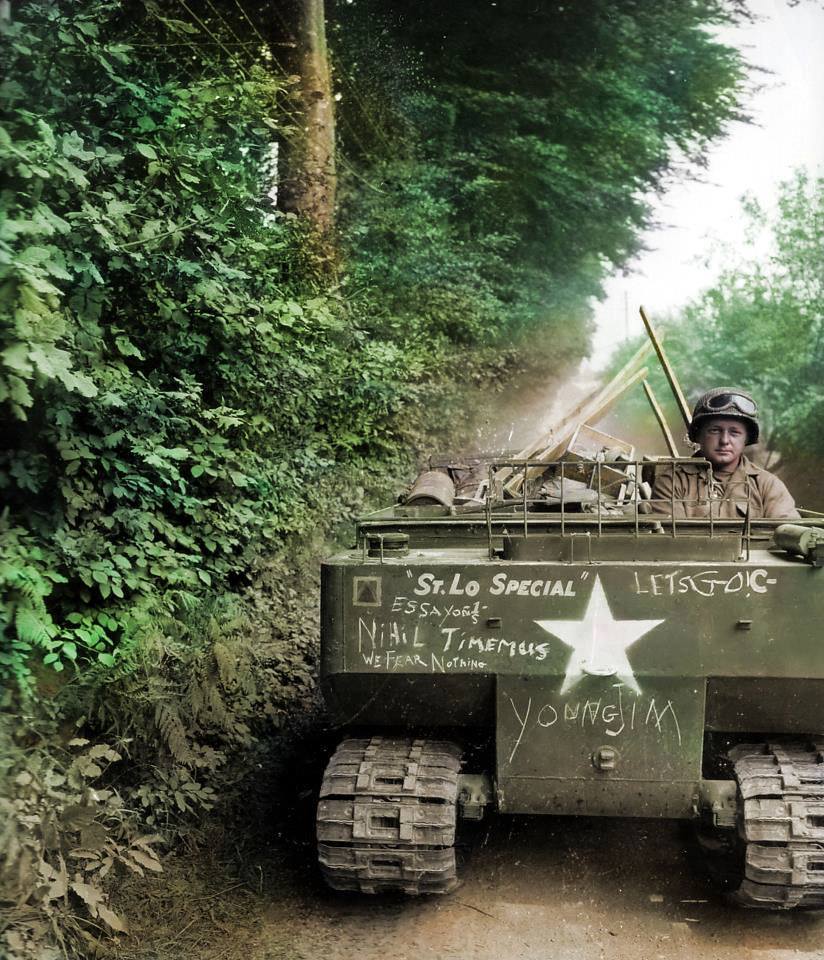
Normandy. c. July 1944.
The 121st landed on Omaha Beach on D-Day, fought the hedgerows and entered St. Lo on the 19th of July ’44
Some of the added chalk written notes,
“Essayons” (French) = 29th Division Motto, “Let us Go”
“Nihil Timemus” (Latin) = 121st Engineers Motto, “We Fear Nothing”
(Source – US National Archives)
(Colourised by Royston Leonard from the UK)
https://www.facebook.com/
Lt John Lee Warner, British Weapon Instructor CBTC (Commando Basic Training Centre), training new US Rangers of the 29th Ranger Battalion in the use of the Thompson M1928A1 SMG.
Commando Basic Training Centre, Achnacarry in the Western Highlands of Scotland.
9th of February 1943.
On Monday, 4 February 1943, ten officers and 166 enlisted men and NCOs of the 29th Infantry Division were sent to Achnacarry, Scotland. The British Commando instructors called this unit, which was undergoing Ranger training, the 2nd Ranger Battalion. However, another American unit also had that designation, so the Rangers in the battalion and the American staff officers called them the 29th Ranger Battalion, named after its division. Major Randy Millholland of the 115th Infantry Regiment, the battalion commanding officer, instructed his men to “keep their eyes and ears open and their mouths shut.” Millholland, a tough, energetic officer, was widely respected. The Ranger trainees were immensely proud of their battalion and did not want to be sent back to their old units as instructors in Ranger tactics. Soon after the proud Rangers completed their training, two of them accompanied a raiding force of British Commandos during an attack on one of the Channel Islands. One of these Rangers covered the withdrawal of his group, killing three German soldiers and wounded several others. By the time of this raid, the 29th Battalion had grown to include four Ranger infantry companies and one headquarters company.
Photo credit The U.S. National Archives and Records Administration
Note: Lt. Lee survived the war and in this image he is wearing the cap badge of the Reconnaissance Corps over a tartan cloth back ground.
(Colourised by Paul Reynolds)
https://www.facebook.com/
Historic Military Photo Colourisations) 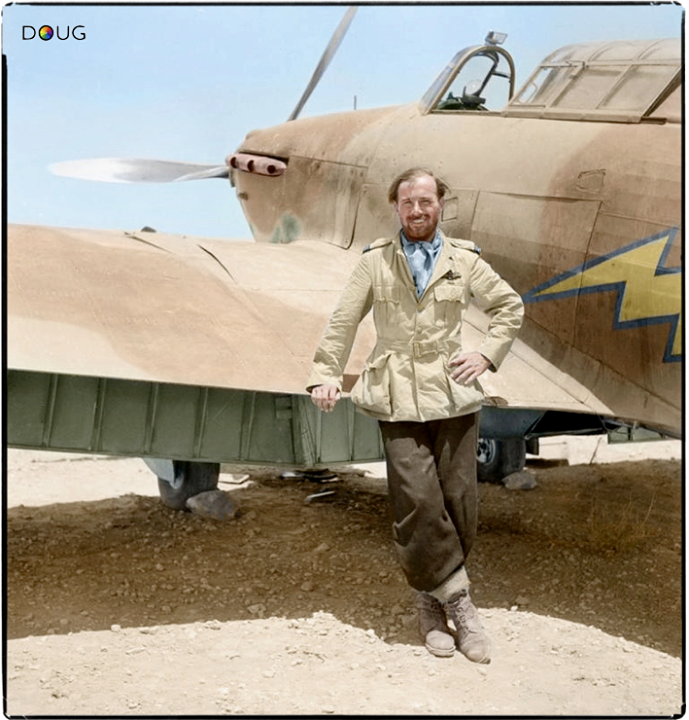
Fl.Lt. Dudley S.G. Honor, Nº 274 Squadron RAF poses by a Hawker Hurricane of the squadron at Gerawala, Egypt, on rejoining his unit following his rescue.
On the afternoon of 25th May 1941, his Mk.I Hurricane (W9266) and that of Fl.Lt Hugh Down were attacking the aerodrome at Maleme, Crete. Down’s plane was hit but Honor shot down an Italian SM79 and a German JU52 before being attacked by a Bf 110 and then a Bf 109. His plane crashed into the sea, sinking some forty feet, but because he was wearing a German self inflatable life jacket, he was able to reach the surface. After a four hour swim he managed to drag himself onto the rocks. He was found by Cretan peasants and a party of Greek soldiers and after six days in hiding was rescued by a passing RAF Sunderland that saw him signalling from his pocket torch. The Sunderland pilot said it was a million to one chance that he was spotted, they were looking for Major General Weston and his staff, with Honor giving directions down the coast, they located the General at Sfakia on about the 31st May.
Dudley Sandry Garton Honor was born, to British parents, on September 5th 1913 at Quilmes, Buenos Aires, Argentina, where he was educated.
He was one of 600 volunteers from Argentina who came to fight with the RAF and RCAF.
Awards: DSO, DFC & Bar
He died on the 26th December 2007 aged 94
© IWM (CM 941)
(The Hurricane is showing a Yellow lightning flash of the 247 Squadron and the front underside of the nose and leading edges sport an Italian camouflage, supposed to confuse Italian ground AA gun crews in North Africa.)
USAAF Capt. Dewey E. Newhart
“Mud N’ Mules” Republic P-47D-15-RE Thunderbolt LH-D s/n 42-76141
350th Fighter Squadron, 353rd Fighter Group, 8th Air Force
Capt. Newhart was killed in action on the 12th of June 1944 during a mission over Northern France.
He was leading the squadron down to strafe an enemy truck convoy near Saint-Saëns, Normandy when he was jumped by 8-10 Bf.109s whilst flying a P-47D LH-U(s/n 42-26402) named “Soubrette”, he was hit and radioed that he was attempting to make landfall.
Before he could escape, he was attacked by two more fighters, and was shot down and killed.
The pictured aircraft was re-assigned to Capt. Lonnie M. Davis who renamed it “Arkansas Traveler” but retained the mule artwork out of respect for Newhart.
(Colourised by Doug)
http://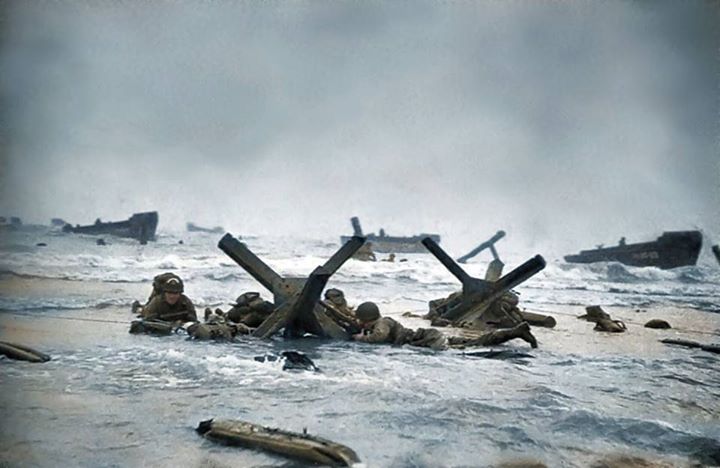
Photographer Robert Capa landed at Easy Red Sector, Omaha Beach with the men of Easy Company, the 2nd battalion, 16th Infantry Regiment, US Army 1st Division.
After completing his task of photographing the landings, Capa’s survival instincts took over. Seeing another craft approaching the beach, he fled towards it. After he was hoisted aboard, the vessel took a direct hit from a German shell and several men on board were killed. Capa survived and transferred to a troop ship for the return journey to England.
On arriving in Weymouth, Dorset, Capa put the four rolls of 35mm film in a courier’s pouch together with several 120mm rolls that he had shot before the invasion. He also included a note to John Morris, Life’s London office picture editor, that stated, ‘John – all the action’s in the 35mm.’ With his films safely on their way, Capa boarded the first boat returning to France.
When the courier arrived at the Life office, Morris urged his staff to develop the films quickly in order to meet the publication deadline. They were given to 15-year-old darkroom assistant Dennis Banks to develop.
The incident that followed has become as famous as Capa’s images. A few minutes later, Banks returned to Morris’s office in tears, saying, ‘They’re ruined! Capa’s films are all ruined!’ In the rush to process and dry the films, Banks had placed them in a wooden drying cabinet and closed the doors. The heat had been so intense that the emulsion had melted and all that was left, as Morris discovered as he examined the films, was ‘a brown sludge in frame after frame’.
Only 11 of the 108 original frames were salvaged.
This photograph is contact screen frame 7/neg. 35
(Colourised by Royston Leonard UK)
https://www.facebook.com/
Pont-Farcy, Basse-Normandie, France.
Photo taken between the 3rd and the 5th of August 1944.
In a village left in ruins, a US Medical truck passes behind a wrecked Panzer IV Ausf. J medium tank of the 2.Panzer-Division.
The Panzer IV formed part of the 8 Kompanie of Panzer Abteilung II, Panzer-Regiment 3 which blocked the crossroads at the centre of Pont-Farcy.
It was destroyed during the liberation of the town by the 35th U.S. Infantry Division on the 2nd of August 1944.
(Note the truck appears to be a GMC CCKW 353 2.5 ton 6X6.)
137th Infantry Regiment, 35th Inf.Div. battle report;
2nd of August 1944
“……at 1530 the 1st Battalion was reported south of les Verges, and the 3rd Battalion at Beau Costil. All battalions were receiving heavy shelling from German artillery and mortar positions west of the Vire River. However, steady progress was made, and the high ground north of the river was cleared of the enemy resistance by 1800. Four enemy tanks reported at the bend of the river north of Pont-farcy were destroyed by Allied aircraft.
At 1845 the main body of the 3rd Battalion was across the river.
With the 2nd and 3rd Battalions across the river, the Division Commander then ordered one battalion to remain north of the river. The 1st Battalion remained, to protect the west flank of the Division.
(Source – National Archives 192520)
(Colourised by Royston Leonard UK)
https://www.facebook.com/
North American P-51 Mustang “Fools Paradise IV” (tail Nº 413309) of the 380th Fighter Squadron, 363rd Fighter Group, 9th USAAF at Maupertuis Airfield near Cherbourg in France. July/August 1944.
Evan M. ‘Mac’ McCall was the squadron commander and also attached to Patton’s 3rd Armored Division as a jeep-mounted Forward Air Controller on the ground in France.
(Note, we have been unable to confirm the correct colour and content of the jeep ‘canvas cover – art work’ but have used our knowledge of WW2 US aircraft ‘nose art’ to arrive at these colours. If anyone can help identify the colours or the name written on the canvas, please message us.)
(Colourised by Benjamin Thomas from Australia)
https://www.facebook.com/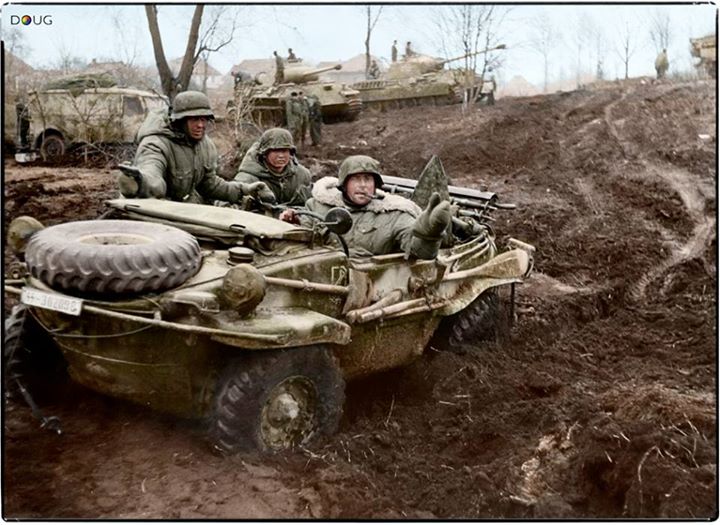
This photo was taken in the Vinnitsa (Vinnytsia) area of the Ukraine in November 1943. The man at the wheel is SS-Hauptsturmführer Gustav Knittel, the commander of the 1st SS Aufklärungs-Abteilung LSSAH at the time. The number plate is 302098, and the vehicle is one of the original Porsche Vorserien Schwimmwagens (literally Floating/Swimming Car) assigned to the LAH in the middle of 1942.
In the background are two Panzerkampfwagen V ‘Panther’ Ausf.A of I.Abteilung / SS-Panzer-Regiment 1 / 1.SS-Panzer-Division LSSAH.
After the war, Knittel was convicted of War Crimes and sentenced to life imprisonment in July 1946.
In March 1948 a reviewing authority reduced his sentence to 15 years imprisonment. In May 1948 the War Crimes Review Board Nr. 4 rejected the claim that irregularities had occurred during the trial against Knittel but following the Simpson Report and the findings of the United States Senate Committee on Armed Services his sentence was further reduced to 12 years imprisonment. Knittel was released from Landsberg Prison on the 7th of December 1953 following a Christmas Amnesty.
Gustav Knittel died on the 30th of June 1976.
(Colourised by Doug)
http://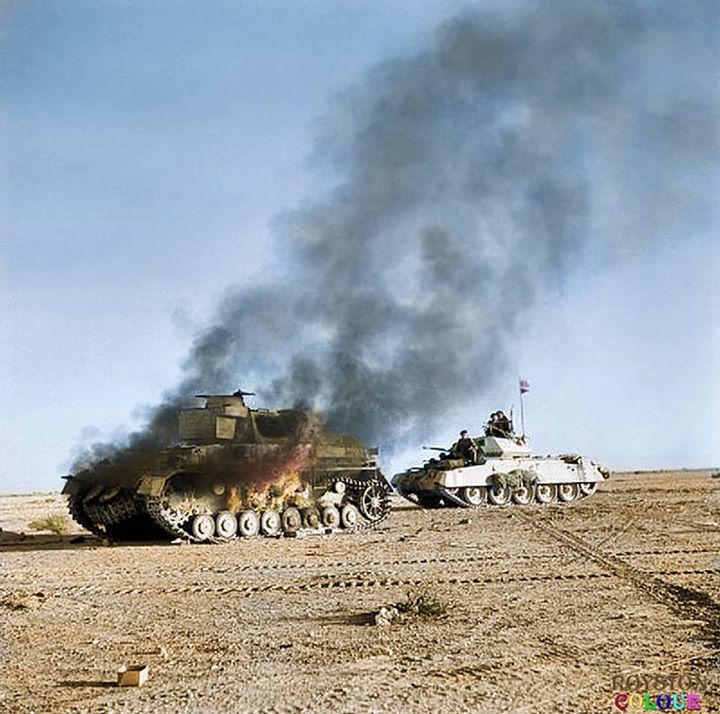
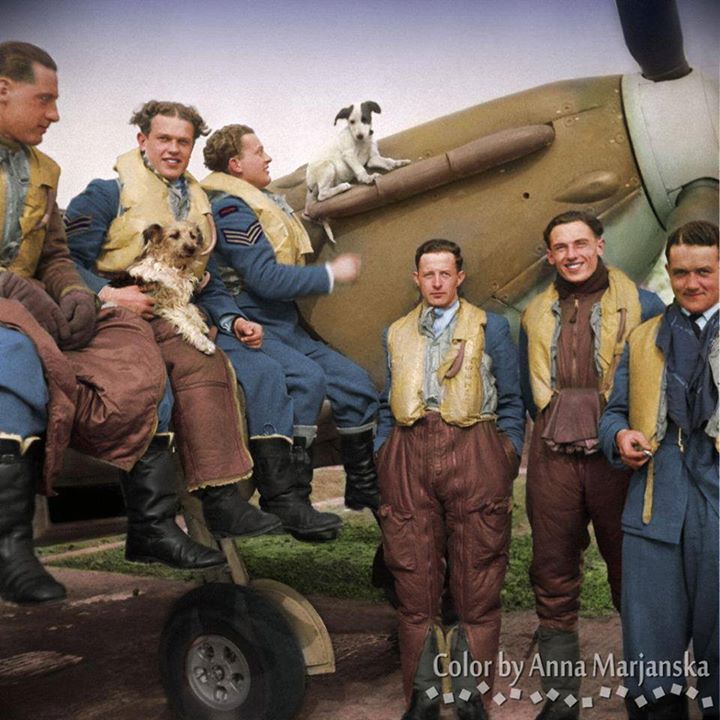
(from left): Sgt Kustrzynski, Sgt Popek, Sgt Szlagowski, F/O Feric, P/O Daszewski and F/O Zumbach.
Kustrzynski, Szlagowski and Zumbach survived the war.
Daszewski was killed in action in 1942.
Feric and Popek both died in active service, 1942 and 1944 respectively.
During the ‘Battle of Britain’, between August 30th and October 11th, No. 303 Squadron tallied 126 enemy aircraft destroyed, 13 probably destroyed and 9 damaged.
(Colourised by Anna Marjańska from Poland)
https://www.facebook.com/
Flying Fortress’ 1942
December 1942, a year after Pearl Harbor. “Production. B-17 heavy bomber. A nearly complete B-17F ‘Flying Fortress’ at Boeing’s Seattle, Washington plant.”
Photo by Andreas Feininger for the Office of War Information.
3,405 were built: 2,300 by Boeing, 605 by Douglas, and 500 by Lockheed (Vega). These included the famous Memphis Belle. 19 were transferred to the RAF, where they served with RAF Coastal Command as the Fortress II. Three examples of the B-17F remain in existence in the 21st century, including the under-restoration Memphis Belle.
(Colorised by Tom Thounaojam) 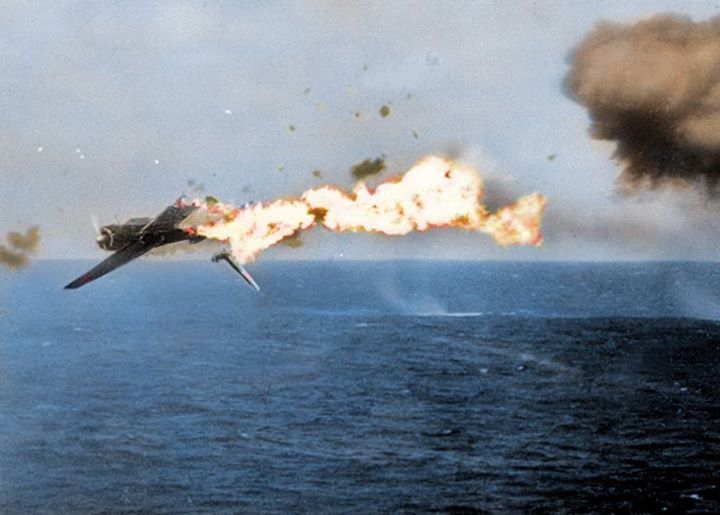
Deck side account, “At 300 yards, the Japanese plane took a shell in its left wing and flames spurted out. The pilot then veered to try to crash into the Yorktown, skimming the flight deck so close that the flames singed the beard of one of the Yorktown gunners. The plane finally crashed into the sea 100 yards close aboard and exploded in a ball of smoke and flame.”
(Photo taken from the aft end of Yorktown’s flight deck, by Chief Petty Officer Photographer’s Mate , Alfred N. Cooperman)
(Colourised by Royston Leonard UK)
https://www.facebook.com/

